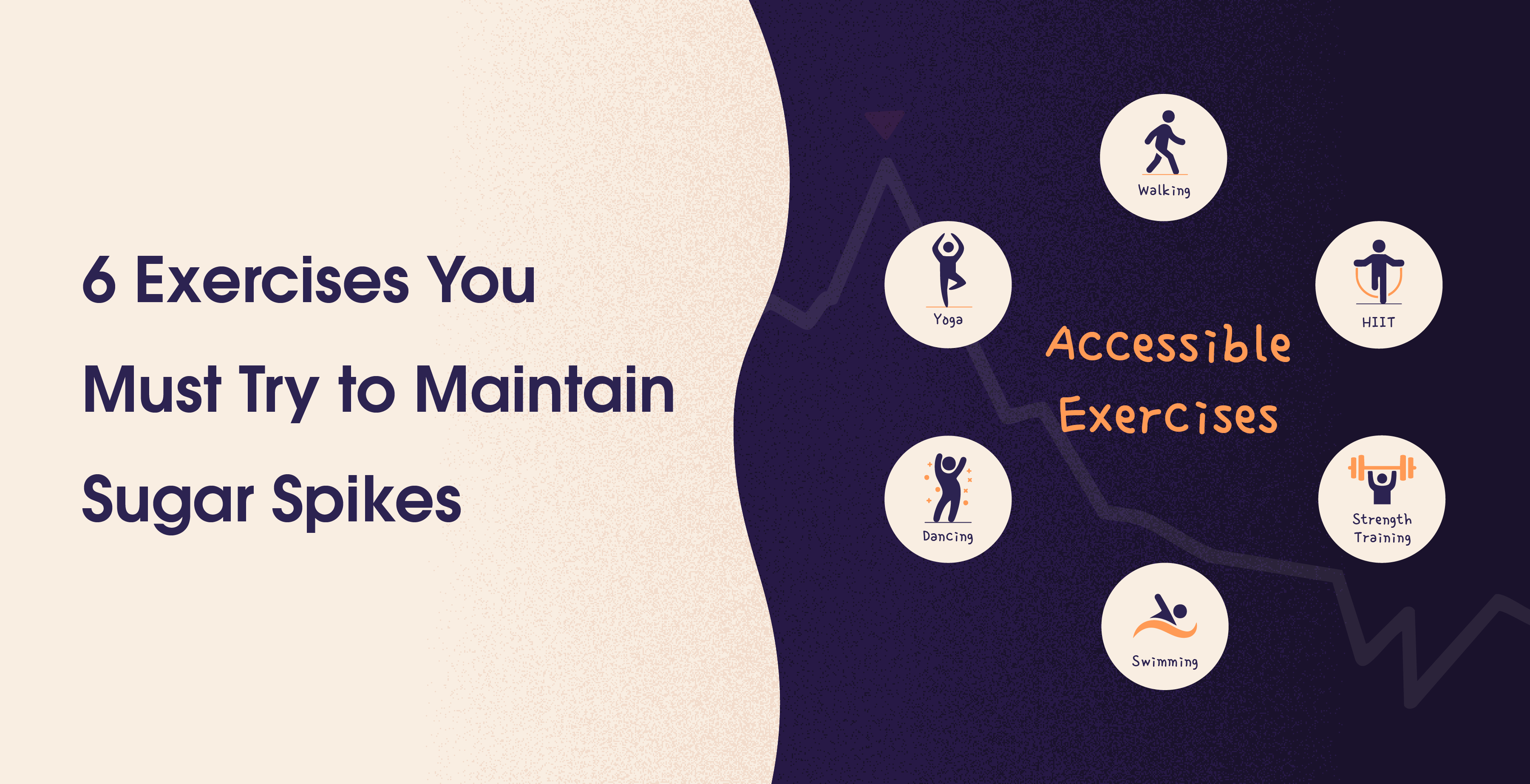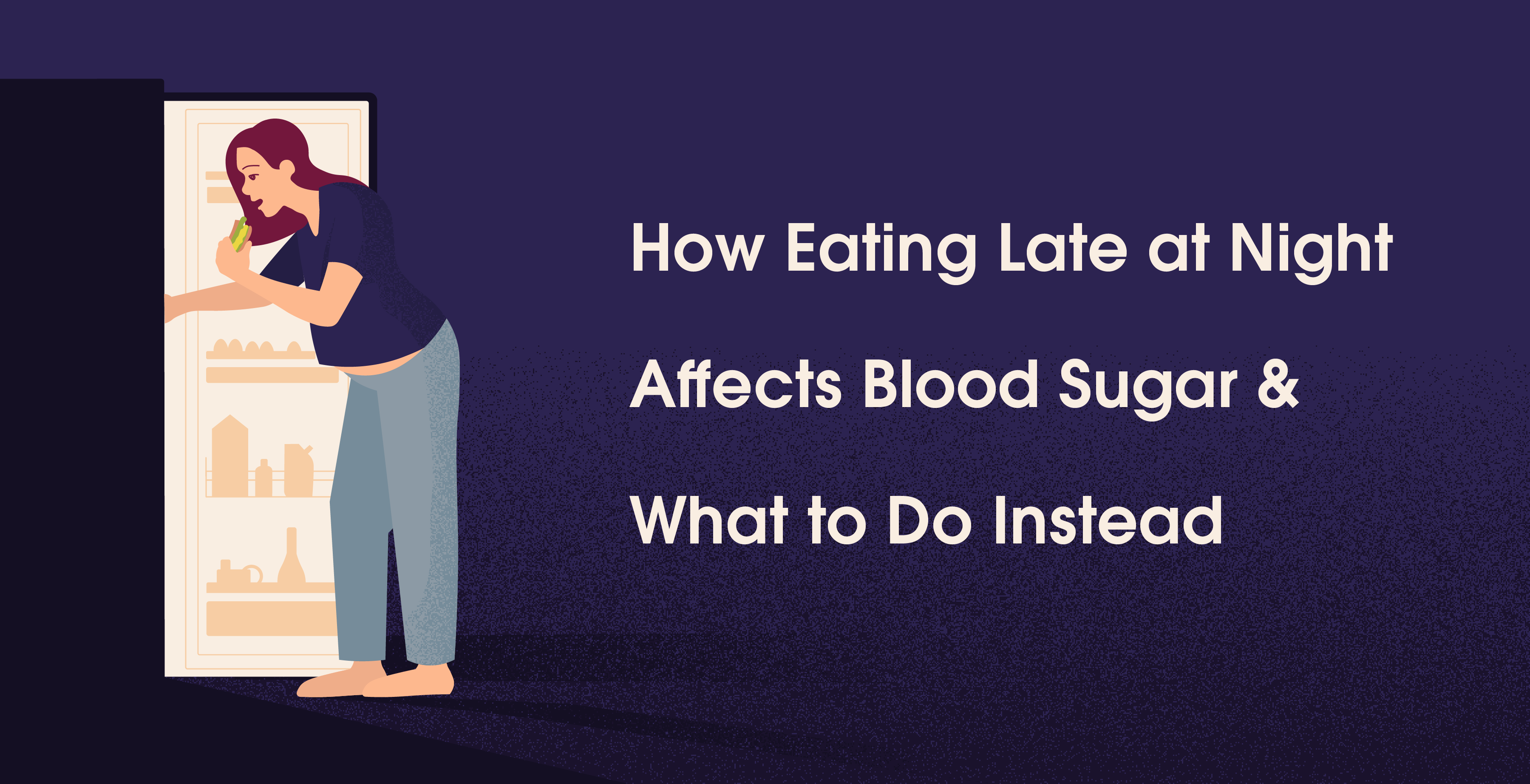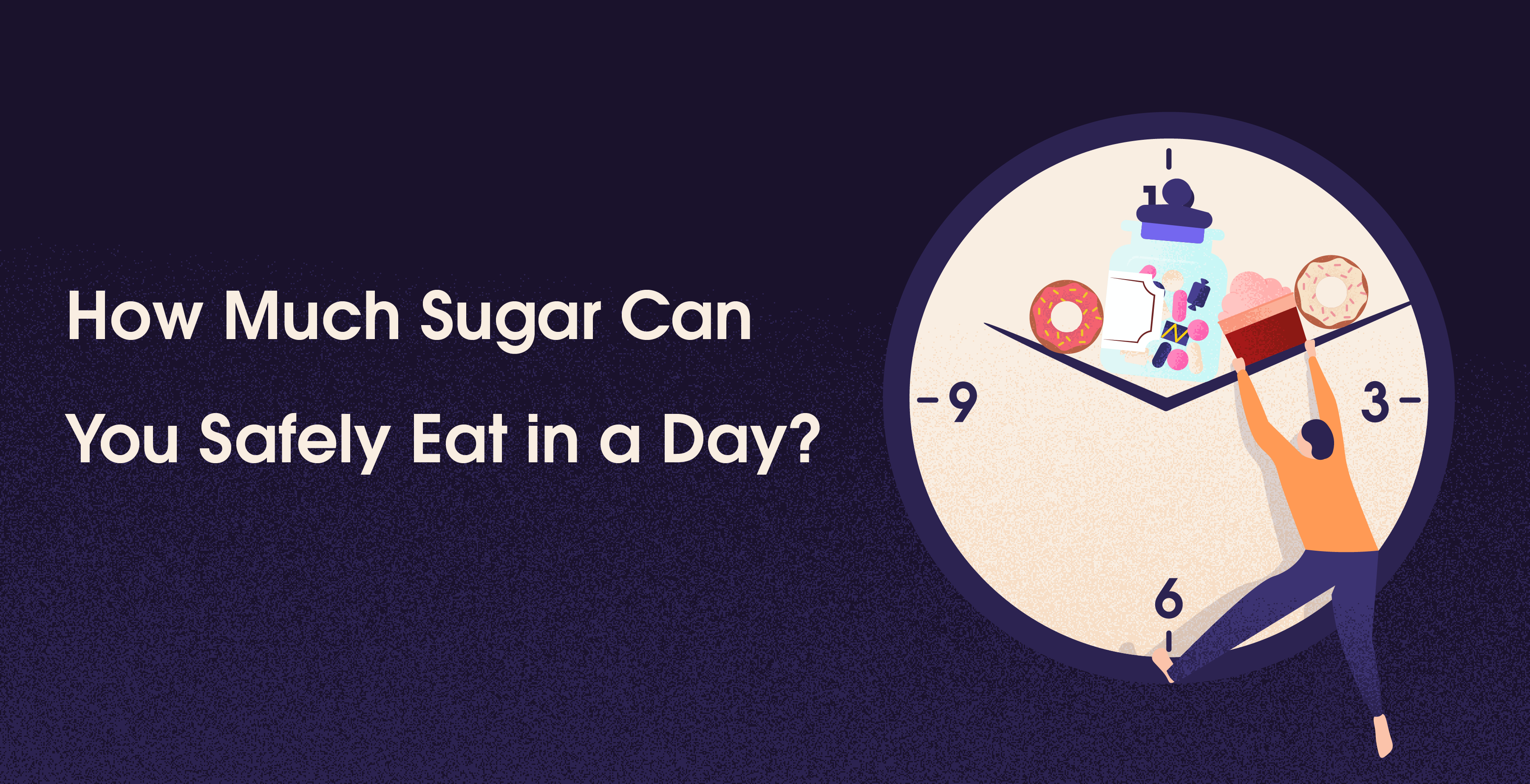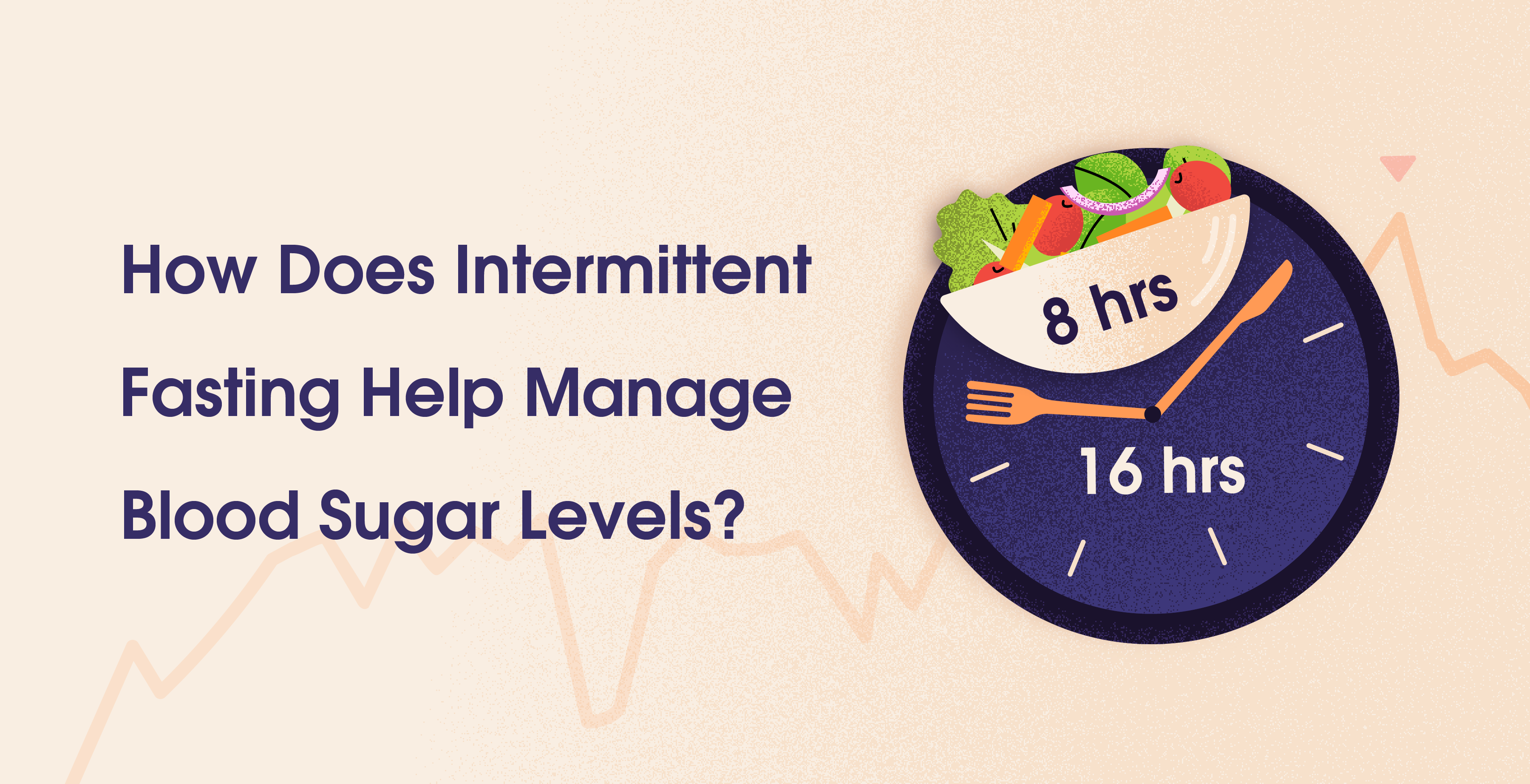6 Exercises You Must Try to Maintain Sugar Spikes
Jan 13, 2025
Sayfali Rawlani



Table Of Contents
Managing sugar levels can feel like a balancing act, but the right kind of movement can make a world of difference. Exercise isn’t just about fitness—it’s a secret weapon for stabilizing blood sugar and keeping those spikes at bay. And no, you don’t have to spend hours sweating it out in the gym. Let’s talk about six easy, accessible exercises that can help you stay on top of your game.
Highlights
Walking for 20-30 minutes after meals helps muscles absorb glucose, naturally reducing sugar levels.
Yoga promotes harmony in the body, improves circulation, and reduces stress, which helps stabilize sugar levels.
Strength practicumenhances muscle function, allowing glucose to be absorbed more efficiently, even with simple exercises like squats or lunges.
Dancing combines cardio and fun, burning glucose while boosting mood and keeping the body active.
Swimming provides a low-impact, full-body workout that enhances insulin efficiency and promotes relaxation.
High-Intensity Interval Training (HIIT) involves short bursts of activity followed by rest, improving glucose management in a time-efficient way.
Consistency in exercise, even with small, enjoyable routines, is key to long-term sugar level stability.
Six easy and accessible exercises to maintain sugar spike
Walking
Walking is proof that the simplest things can be the most effective. A brisk 20-30 minute walk after meals helps your muscles soak up glucose, reducing sugar levels naturally. The best part? Walking fits into any routine—whether it’s a stroll in the park, pacing while on a call, or a quick walk around the block after dinner. It’s a low effort but a high reward.
Yoga
Yoga is more than stretching—it’s about creating harmony in your body. Postures like Warrior Pose, Tree Pose, or gentle stretching routines improve circulation and reduce stress. Stress, as we know, loves to throw your sugar levels out of whack. With yoga, you get dual benefits—calmer nerves and better blood sugar management—all while moving at your own pace.
Strength Training
Lifting weights or using resistance bands isn’t just about building muscle—it’s about giving your body more tools to regulate glucose. Stronger muscles act like sponges, absorbing sugar from your blood and putting it to good use. And you don’t need heavy equipment; squats, lunges, or even lifting household items can do the trick.
Dancing
Who says managing sugar has to be boring? Dancing is cardio disguised as fun. Turn up your favorite music, and let loose—it’s not about perfect moves but keeping your heart rate up. Whether it’s salsa, freestyle, or a quick dance-off in your living room, it’s an enjoyable way to burn off glucose and lift your mood at the same time.
Swimming
Swimming is perfect if you want a low-impact, full-body workout. The water takes the strain off your joints while letting you move freely, making it an excellent option for all fitness levels. As you swim, your body becomes better at using insulin, leading to more stable sugar levels. Plus, it’s calming and rejuvenating—perfect for a post-workday reset.
HIIT
High-Intensity Interval Training, or HIIT, is ideal for anyone short on time. Short bursts of intense movement—think jumping jacks, jogging in place, or burpees—followed by brief rest periods can improve how your body uses sugar. It’s quick, effective, and keeps your metabolism revved up long after you’re done. Start small and build intensity as you go—there’s no rush to push beyond your limits.
It’s About Finding Your Groove
There’s no one-size-fits-all when it comes to exercise, especially if you’re trying to manage blood sugar. The key is to find what works for you and stick with it. Whether you’re walking, dancing, or trying out yoga for the first time, consistency beats intensity every time. And don’t forget to celebrate the small wins—whether it’s a slightly lower reading on your glucose monitor or just feeling more energized.
So, lace up those sneakers, roll out that yoga mat, or crank up your favorite song. Your blood sugar (and your future self) will thank you.
References
Managing sugar levels can feel like a balancing act, but the right kind of movement can make a world of difference. Exercise isn’t just about fitness—it’s a secret weapon for stabilizing blood sugar and keeping those spikes at bay. And no, you don’t have to spend hours sweating it out in the gym. Let’s talk about six easy, accessible exercises that can help you stay on top of your game.
Highlights
Walking for 20-30 minutes after meals helps muscles absorb glucose, naturally reducing sugar levels.
Yoga promotes harmony in the body, improves circulation, and reduces stress, which helps stabilize sugar levels.
Strength practicumenhances muscle function, allowing glucose to be absorbed more efficiently, even with simple exercises like squats or lunges.
Dancing combines cardio and fun, burning glucose while boosting mood and keeping the body active.
Swimming provides a low-impact, full-body workout that enhances insulin efficiency and promotes relaxation.
High-Intensity Interval Training (HIIT) involves short bursts of activity followed by rest, improving glucose management in a time-efficient way.
Consistency in exercise, even with small, enjoyable routines, is key to long-term sugar level stability.
Six easy and accessible exercises to maintain sugar spike
Walking
Walking is proof that the simplest things can be the most effective. A brisk 20-30 minute walk after meals helps your muscles soak up glucose, reducing sugar levels naturally. The best part? Walking fits into any routine—whether it’s a stroll in the park, pacing while on a call, or a quick walk around the block after dinner. It’s a low effort but a high reward.
Yoga
Yoga is more than stretching—it’s about creating harmony in your body. Postures like Warrior Pose, Tree Pose, or gentle stretching routines improve circulation and reduce stress. Stress, as we know, loves to throw your sugar levels out of whack. With yoga, you get dual benefits—calmer nerves and better blood sugar management—all while moving at your own pace.
Strength Training
Lifting weights or using resistance bands isn’t just about building muscle—it’s about giving your body more tools to regulate glucose. Stronger muscles act like sponges, absorbing sugar from your blood and putting it to good use. And you don’t need heavy equipment; squats, lunges, or even lifting household items can do the trick.
Dancing
Who says managing sugar has to be boring? Dancing is cardio disguised as fun. Turn up your favorite music, and let loose—it’s not about perfect moves but keeping your heart rate up. Whether it’s salsa, freestyle, or a quick dance-off in your living room, it’s an enjoyable way to burn off glucose and lift your mood at the same time.
Swimming
Swimming is perfect if you want a low-impact, full-body workout. The water takes the strain off your joints while letting you move freely, making it an excellent option for all fitness levels. As you swim, your body becomes better at using insulin, leading to more stable sugar levels. Plus, it’s calming and rejuvenating—perfect for a post-workday reset.
HIIT
High-Intensity Interval Training, or HIIT, is ideal for anyone short on time. Short bursts of intense movement—think jumping jacks, jogging in place, or burpees—followed by brief rest periods can improve how your body uses sugar. It’s quick, effective, and keeps your metabolism revved up long after you’re done. Start small and build intensity as you go—there’s no rush to push beyond your limits.
It’s About Finding Your Groove
There’s no one-size-fits-all when it comes to exercise, especially if you’re trying to manage blood sugar. The key is to find what works for you and stick with it. Whether you’re walking, dancing, or trying out yoga for the first time, consistency beats intensity every time. And don’t forget to celebrate the small wins—whether it’s a slightly lower reading on your glucose monitor or just feeling more energized.
So, lace up those sneakers, roll out that yoga mat, or crank up your favorite song. Your blood sugar (and your future self) will thank you.
References
Table Of Contents
Table Of Contents
Table Of Contents
Read More


Mar 25, 2025
Sayfali Rawlani


Mar 20, 2025
Sayfali Rawlani


Mar 6, 2025
Sayfali Rawlani



Copyright © 2025 trst health. All right reserved.

